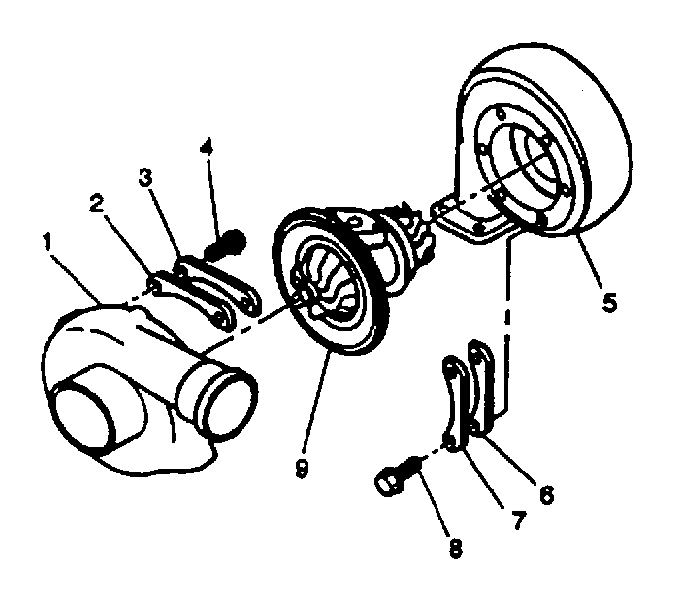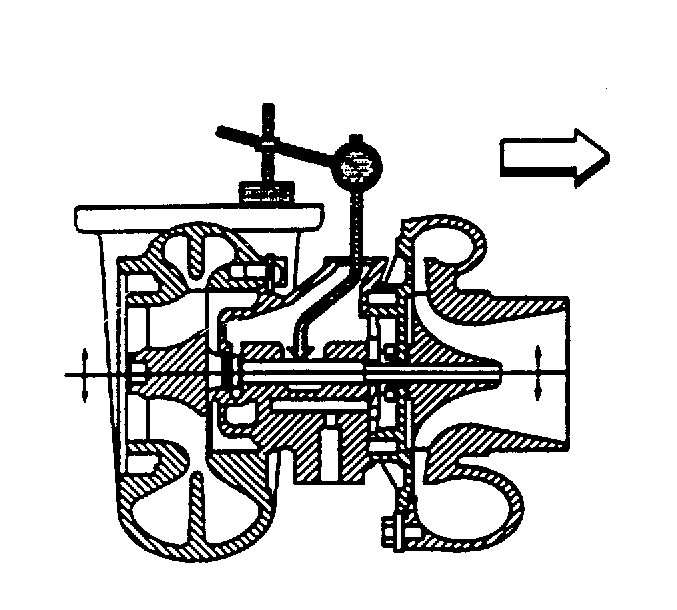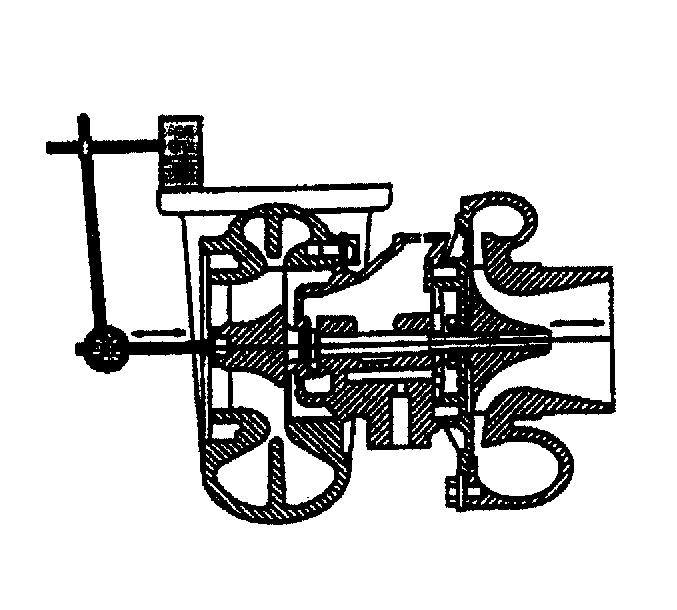
Removal Procedure
- Tilt the cab. Refer to Cab Tilting in General Information.
- Disconnect the negative battery cables. Refer to Battery Negative Cable Disconnection and Connection in Engine Electrical.
- Remove the air inlet hose from the air intake duct.
- Remove the air inlet hose from the turbocharger.
- Remove the air inlet from the charge air cooler.
- Remove the exhaust from the turbocharger. Refer to Exhaust Pipe Replacement in Engine Exhaust.
- Remove the heat shield at the starter.
- Remove the coolant feed line.
- Remove the coolant return line.
- Remove the oil feed line.
- Remove the oil return line.
- Remove the exhaust manifold with the turbocharger. Refer to Exhaust Manifold Replacement in Engine Exhaust.
- Remove the turbocharger from the exhaust manifold.
Inspection Procedure
Inspect for the following conditions:
| • |

|
| • |
Adjustment Procedure
Bearing Radial Clearance
- Use a dial indicator with an offset plunger and a magnetic base. Adjust the plunger so that it touches the turbocharger main shaft and readjust the gauge to zero.
- Hold the turbocharger, move the compressor wheel up and down, and read the radial clearance. Clearance should be 0.076-0.152 mm (0.003-0.006 in).

Adjustment Procedure
Compressor End Play
- Use a dial indicator with a magnetic base. Adjust the plunger so that it touches the turbocharger main shaft and readjust the gauge to zero.
- Move the turbocharger mainshaft back and forth and read the end play. Clearance should be 0.025-0.076 mm (0.001-0.003 in).
- If the bearing radial clearance or the compressor end play is out of specifications, replace the turbocharger center section assembly.

Disassemble Procedure
Important: Scribe an alignment mark across the compressor housing, center assembly, and the turbine housing. These parts must be reassembled in the original location.
- Remove the bolts, lock plates, and clamps from the turbocharger.
- Remove the compressor housing (1).
- Remove the turbine housing (5).

Assemble Procedure
Important:
• Handle the center assembly with care. The assembly is precisely
balanced. Even minor scratches or distortion can cause a malfunction. • Do not attempt to disassemble the center assembly. Replace as
a unit if faulty.
- Install the turbine housing (5) to the center assembly (9). Align the scribe marks made at disassembly.
- Install the compressor housing (1) to the center assembly (9).
- Install the clamps, plates, and bolts.

Notice: Use the correct fastener in the correct location. Replacement fasteners must be the correct part number for that application. Fasteners requiring replacement or fasteners requiring the use of thread locking compound or sealant are identified in the service procedure. Do not use paints, lubricants, or corrosion inhibitors on fasteners or fastener joint surfaces unless specified. These coatings affect fastener torque and joint clamping force and may damage the fastener. Use the correct tightening sequence and specifications when installing fasteners in order to avoid damage to parts and systems.
Tighten
Tighten the bolts to the compressor housing to 23 N·m (17 lb ft).
Tighten the bolts to the turbine housing to 23 N·m (17 lb ft).
Inspection Procedure
Assembly for proper operation--Turn the compressor wheel by hand. The wheels must rotate freely without binding or noise.

Installation Procedure
- Install the gasket with the plain side towards the exhaust manifold.
- Install the turbocharger to the exhaust manifold.
- Tighten the washer and nuts to the exhaust manifold studs.
- Install the oil drain tube and the gaskets to the turbocharger and the oil pan.
- Install the exhaust manifold and turbocharger assembly. Refer to Exhaust Manifold Replacement in Engine Exhaust.
- Install the oil feed line to the turbocharger.
- Install the joint bolt to the oil feed line.
- Connect the gasket to the exhaust pipe adapter.
- Connect the exhaust pipe adapter to the turbocharger.
- Install the bolts and washers.
- Connect the heat shield to the starter.
- Install the coolant feed lines.
- Install the coolant return lines.
- Connect the air inlet hose to the charge air cooler.
- Connect the air inlet hose to the turbocharger.
- Connect the air inlet hose to the air intake duct.
- Connect the negative battery cables.
- Lower the cab.
Notice: Use the correct fastener in the correct location. Replacement fasteners must be the correct part number for that application. Fasteners requiring replacement or fasteners requiring the use of thread locking compound or sealant are identified in the service procedure. Do not use paints, lubricants, or corrosion inhibitors on fasteners or fastener joint surfaces unless specified. These coatings affect fastener torque and joint clamping force and may damage the fastener. Use the correct tightening sequence and specifications when installing fasteners in order to avoid damage to parts and systems.
Tighten
Tighten the nuts to 52 N·m (38 lb ft).
Tighten
Tighten the bolts to 27 N·m (20 lb ft).
Important: Prelubricate the turbocharger bearings with 4 fluid ounces (118.3 ml) of clean engine oil. Pour the clean engine oil into the oil feed port.
Turn the compressor wheel by hand to distribute the oil in the turbocharger. Failure to do so could cause damage to the turbocharger.Tighten
Tighten the joint bolts to 18 N·m (13 lb ft).
Tighten
Tighten the bolts to 26 N·m (19 lb ft).
